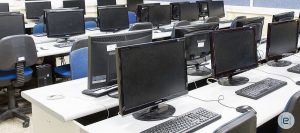What if Universities could leverage computer labs to give students remote anywhere access without the need to purchase new computers or run virtual machines in the cloud?
University Going Virtual on a Budget
A major Midwestern University plans to operate virtually in the fall. With COVID, administrators are looking at how to provide students with virtualized systems to achieve new normal productivity. They want to bring their labs online to provide students remote anywhere access to what used to be in person reserved systems.
The goal is to broker connections to a farm of 300 MACs and up to 2,400 PCs to eliminate the one-to-one management overhead of the inbound connections. The University owns the machines and wants to stay within budgets.
While this functionality can be setup in Azure, consumption on Azure would cost the University more than the funds allotted for the project. Furthermore, it idles systems they already own.
Greatly Expanded Virtual Environment
Currently, the University has the capacity to run about 500 Virtual PC systems. But they want to scale to five times that number. They have no way of determining demand, but the end of fall/winter terms and the beginning of fall/winter terms see the most use.
The biggest challenge is a greatly expanded virtual environment, virtual Macintosh systems used for communications, art and music classes, and virtual systems with MIDI physical equipment connected.
The University could put 50 Mac Minis they have on a shelf to provide remote connectivity. But managing a one-to-one virtual to physical environment becomes labor intensive. Classroom Mac’s could have monitors removed and dedicated for remote access but again this is one-to-one virtualization.

Variable by Class
Currently, the University configures systems with a base image and then installs software to meet the class or individual requirements. The IT staff employs Microsoft System Center Configuration Manager (SCCM) to manage software deployment.
University leaders want a virtual environment where they can create multiple virtual templates for each discipline/class (around 15). One issue is licensing. Hence, they want to save costs by monitoring concurrent license usage.
Unified Workspace for Legacy and Cloud Apps
eMazzanti Access provides a unified workspace that offers a highly secure and audited access to organization files and legacy, web and SaaS applications in a browser-based workspace, accessible via any browser, on any device. It offers a very intuitive user interface, a mobile app for tablets and expanded administration tools for greater control and auditing.
The Challenge:
-
- 2,400 windows PCs and 300 Macs sitting in the PC labs of a large University
- To enable social distancing, the University wants to make 50% of the PCs and Macs available remotely (as opposed to usage in the classroom) for anywhere access
- Minimize infrastructure and licensing costs
eMazzanti Anywhere Access Solution
To solve the problem, the University PCs can be connected per Remote Desktop Protocol (RDP) into eMazzanti Access with the role enabled on each device. PCs are grouped using ‘labels’ in eMazzanti Access with a label for each class or other logical grouping. This assumes a dedicated purpose for each physical PC, such as a dedicated class.

Secure Login
Students login on eMazzanti Access via a browser on their own device (BYOD) and take remote control of a PC running in the University PC lab. Administrators import users and groups from the active directory (AD).
-
- Users authenticate with their AD credentials and get single sign-on (SSO) authentication into the PCs.
- Each group has its own rights to access the designated PCs for their class.
- When a user performs a login, they see several icons. Each icon represents a class or group of PCs.
When the user clicks an icon, eMazzanti Access assigns the first available PC based on round robin scheduling. This setup assumes that users are known in AD (or LDAP) and the PCs are connected to AD.
Cost Minimized
This innovative eMazzanti Access setup incurs limited infrastructure and licensing costs. For example, with 1,200 PCs, eMazzanti deploys the solution on 4 virtual machines (8vCPU and 8Gb). There is also no Microsoft Remote Desktop Services (RDS) licensing applicable with no server access.
Simplified Anywhere Access
eMazzanti Access delivers IT services securely and efficiently. Users work and collaborate from an online unified workspace and can access any application, anywhere. Moreover, personal or organization devices require no agent installation. Users only need an HTML5 browser-capable device and an internet connection.
The solution empowers leaders to mobilize all organization applications without making changes to existing software or backend infrastructure. eMazzanti Access connects to applications independent of where they run, whether SaaS (e.g. Office 365) or legacy applications such as AS400.
As in the University example above, eMazzanti Access is also a safe and simple way to implement BYOD. It is SSL-encrypted, offers two-factor authentication and is auditable. All IT assets remain centrally managed and secure, and personal or corporate devices require no agent installation.






